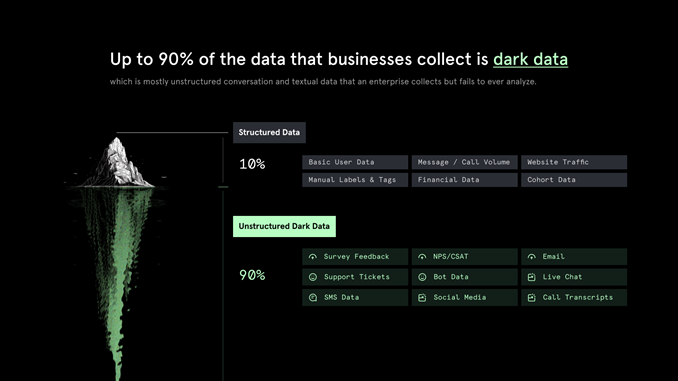Home > Columns > Executive Interviews
Dashbot Executive Interview

Eric Griffing, Head of Growth, Dashbot
Click image below to view the ebook 
Sheri Greenhaus, Managing Partner of CrmXchange, spoke with
Eric Griffing, Head of Growth of Dashbot, a data platform, which offers
insights from unstructured data in customer interactions, benefiting large
organizations in various industries. They discussed how Dashbot helps analyze
customer journeys, optimize AI, and mitigate risks in AI implementations while
emphasizing the value of unstructured data for understanding customer
sentiments.
Sheri: Can you tell us about Dashbot
Eric: Dashbot has been around for nearly a decade. We
service large organizations with a high volume of customer interactions,
including industries such as insurance, airlines, tech, and financial services.
We are a data platform for unstructured data (chatbots, live chat, voice, text)
that helps our customers analyze different customer interactions. Customers
typically interact with businesses across multiple channels, and we combine all
of these data sources together to provide valuable customer insights.
Sheri: In essence, you are providing a single source of
truth for the customer's journey.
Eric: Yes, our platform visualizes user journeys. Instead
of looking at a single interaction with a customer, like a single phone call or
a social media post, it provides a lot more context by understanding what
happened before and after each interaction.

Sheri: Your platform compiles the data so a company can
look at a customer journey and assess the final outcome. What is then done with
all the data?
Eric: That's a good question. In large companies with
multiple teams, often the data is siloed. Each team may focus on a specific
channel or aspect of customer interaction. Our goal is to bring all these
client-facing teams together and provide them with cross-channel data for
analysis. Every customer interaction can have positive or negative sentiment,
and we help identify the causes of negative sentiments, such as refunds or
other issues that impact a company financially.
Sheri: With drilling down, is the analytics and the data
residing with you?
Eric: There is a three-step process. First, you connect
all your data sources to Dashbot. Second, you perform analytics and data
exploration using our tool called Data Slicer, which allows you to delve into
unstructured data. Third, you create custom dashboards to monitor changes over
time. We provide the tools for you to explore and analyze the data effectively.
Sheri: What does a company receive when they get Dashbot?
Eric: It depends on the company, but we usually start
with one data source. For example, we can export customer surveys or connect to
contact center data. We aim to show immediate value by letting you connect any
data source. Over time, you can connect additional sources, and our customer
success team helps build initial dashboards.
Sheri: I assume the real value comes from identifying all
the different channels someone's coming in on and analyzing the overall
picture.
Eric: Absolutely, it's about pulling together data from
various channels and understanding the qualitative aspects of customer
sentiment. We extract valuable insights from unstructured data like open-ended
survey questions, giving you a more comprehensive view of customer sentiment.
Sheri: Multiple words can mean the same thing. How does the
system aggregate similar sentiments?
Eric: We use several models and databases to continuously
improve sentiment understanding.
Sheri: What is the profile of the organization that can
best use Dashbot?
Eric: We work with organizations that have a lot of data
and want to improve customer experience. If you have a significant amount of
customer data generated across various channels, Dashbot can help you gain
new insights.
Sheri: What type of technologies do you complement?
Eric: We are not the end solution like an IVR or a
chatbot builder; we partner with them to provide data labeling, analytics and
optimization. We excel when an enterprise has a stack of tools and a need to
quickly pull together and analyze data. We have a universal API that integrates
with most data sources or supports CSV uploads.
Sheri: Can companies provide better information to bots
based on the insights gained from Dashbot's analytics?
Eric: Yes, the second half of Dashbot is optimization. We
help identify intents that bots might not be picking up on, allowing you to
train your models to improve accuracy.
Sheri: Many organizations are looking at AI solutions. How
can you help?
Eric: We help organizations hedge the risk of launching
AI by allowing them to tap into their existing customer data to understand
where the best automation opportunities lie and to track and optimize it
in a controlled environment before a full-scale rollout. This ensures AI
implementations are successful and customer-friendly.
Sheri: Is there anything else our audience should know
about Dashbot?
Eric: Think of structured data
as the tip of the iceberg, while unstructured data represents the bulk below
the surface. We believe analyzing all unstructured data provides a better daily
pulse on how your customers are feeling. Dashbot helps you tap into this
valuable resource for a deeper understanding of your customer's experiences.